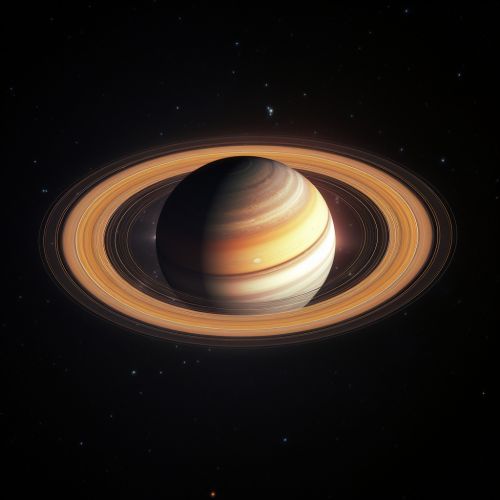Saturn
Overview
Saturn is the sixth planet from the Sun in our Solar System. It is a gas giant, second in size and mass only to Jupiter. Saturn is known for its extensive ring system, composed primarily of ice particles with a smaller amount of rocky debris and dust.


Physical Characteristics
Saturn is a gas giant, composed primarily of hydrogen and helium, similar to Jupiter. The planet's outer atmosphere is generally bland in appearance, although long-lived features can appear. Saturn's interior is probably composed of a core of iron, nickel, and rock, surrounded by a deep layer of metallic hydrogen, an intermediate layer of liquid hydrogen and liquid helium, and finally, an outer gaseous layer.
Atmosphere
Saturn's atmosphere exhibits a banded pattern similar to Jupiter's, but Saturn's bands are much fainter and are much wider near the equator. The composition of the clouds varies with depth and increasing pressure. In the upper cloud layers, with the temperature in the range of 100–160 K and pressures extending between 0.5–2 bar, the clouds consist of ammonia ice.
Magnetosphere
Saturn has an intrinsic magnetic field that has a simple, symmetric shape – a magnetic dipole. Its strength at the equator – 0.2 gauss (20 µT) – is approximately one twentieth of that of the field around Jupiter and slightly weaker than Earth's magnetic field.
Orbit and Rotation
Saturn is the only planet of the Solar System that is less dense than water. Despite its larger size, Saturn would float in water while Earth would sink. The planet completes a rotation about its axis every 10.5 hours, creating a bulge at its equator.
Natural Satellites
Saturn has 82 known moons, 53 of which have formal names. In addition, there is evidence of dozens more awaiting confirmation of their discovery. The largest of the moons is Titan, which is the second-largest moon in the Solar System after Jupiter's Ganymede, and is larger than the planet Mercury.
Exploration
Saturn has been visited by four spacecraft: Pioneer 11, Voyager 1, Voyager 2 and Cassini-Huygens, with most of our current knowledge being derived from the Cassini mission.
